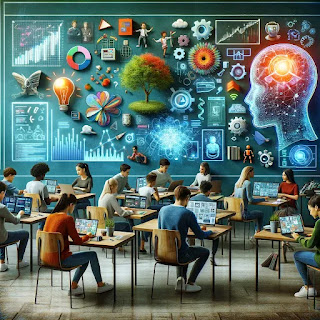Opening a new horizon
Dr Theo M. Ammari, May 2024
(I created this image using DALL-E on chatGPT-4o)
Unleashing Creativity by Using AI Tools
Use AI to provide numerous
opportunities for your students to
develop their creativity. Start by
integrating AI tools and platforms
that encourage exploration,
experimentation, and innovative
thinking into your curriculum. For
instance, AI-driven design
programs, coding platforms, and
creative writing assistants can
offer students new ways to
express their ideas and solve
problems. These tools can help
students visualise concepts, test
hypotheses, and receive instant
feedback.
Mistakes are crucial for learning; do not penalise students for making mistakes
Encourage students to take risks
and understand that making
mistakes is a natural learning process. Create a
classroom environment where
mistakes are seen as valuable
learning experiences rather than
failures. Implement a structured
reflective practice where students
analyse their errors, understand
why they happened, and think
about how to improve. This could
involve journaling, group
discussions, or using AI to track
progress and highlight areas for
growth.
Make it explicitly clear to students
that they will only be penalised for
not learning from their mistakes,
not for making them.
This
approach emphasised the
importance of resilience and
continuous improvement. Students
should understand that the goal is
to learn and grow rather than to
achieve perfection on the first try.
Paradigm change is inevitable!
We need a paradigm shift: we must
move away from simply teaching
creativity and instead cultivate an
environment that nurtures it in our
students. This paradigm change is
necessary because traditional teaching methods often stifle
creativity by focusing too much on
rote learning and standardised
testing. In today’s rapidly changing
world, thinking creatively and adapting to new challenges is
crucial. By changing our approach,
we can better prepare students
for the complexities of the future.
This can be achieved by
encouraging open-ended projects,
interdisciplinary learning, and real-world problem-solving scenarios
where AI can be a collaborative tool
rather than a prescriptive one. For
example, students can work on
projects that combine art and
technology or use AI to analyse
data for science experiments.
Generative AI - A Golden opportunity!
AI offers us a golden opportunity
to make this change, providing
personalised feedback,
suggesting new approaches, and
even identifying patterns in
student work that may indicate
creative strengths or areas for
growth. AI can adapt to each
student’s learning style and pace,
providing customised resources and
challenges that push their creative
boundaries.
In this new paradigm, teachers act
as facilitators, guiding students in
their creative processes and helping
them leverage AI to enhance their
learning.
This involves teaching
students how to use AI tools
effectively, critically evaluate AI-generated suggestions, and integrate
AI into their creative workflows.
Teachers can also model creative
thinking and problem-solving,
showing students how to approach
challenges with curiosity and an
open mind.
This approach develops creativity and prepares
students for a future where
adaptability and innovative
thinking are essential. By
embracing AI in education, we can
transform our classrooms into
dynamic spaces where creativity
thrives and students are
empowered to take ownership of
their learning journeys. This shift
will help produce not just
consumers of information but
creators and innovators equipped to tackle tomorrow's challenges.





No comments:
Post a Comment